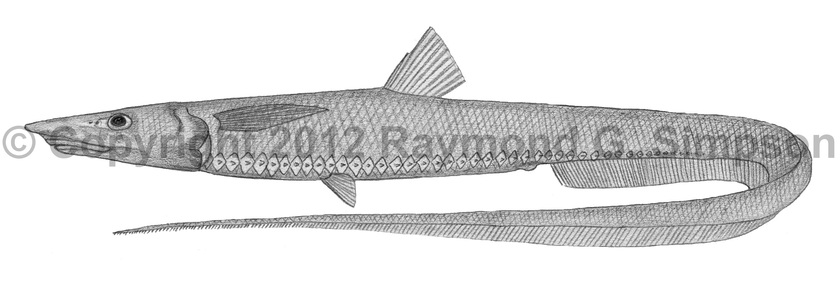
Common Name
Hawaiian Halosaur
Year Described
Vaillant, 1888
Identification
Dorsal Fin: 10-12
Anal Fin:
Pectoral Fin: 11-13
Pelvic Fin: I, 8
Lateral Line Scales: 24-28 (to anus)
Branchiostegal Rays:
Gill Rakers: 19-23 (total on first arch)
Pyloric Caeca: 5-8
Body very elongate and moderately compressed. Skin firm. Mouth relatively small. Palatine tooth patch separated from pterygoid by a distance less than half its length. Snout relatively short. Scales absent on top of head and opercle. Lateral line scales two times larger than the body scales. Lateral line scales continuous with each other. First dorsal ray is very short and vestigial. Dorsal fin origin posterior to pelvic fin origin.
Color
Body light gray with a silvery-blue sheen on the sides. Vent white.
Size
Maximum size to 50cm TL.
Habitat
Benthopelagic from 500-2,300m. Over soft calcareous ooze.
Range
Off the E. U.S. from New England to the Bahamas. Also off S. Brazil.
References
McDowell, S.B. In: Cohen, D.M., N.B. Marshall, A.W. Ebeling, D.E. Rosen, T. Iwamoto, P. Sonoda, S.B. McDowell, W.H. Weed III, and L.P. Woods. 1973. Fishes of the Western North Atlantic. Part 6. Hereromi, Cyprinodontoidei, Berycomorphi, Xenoberyces, Anacanthini. Memoir No. 1. Sears Foundation for Marine Research; Yale University, New Haven, CT. 698 pp., 235 plates.
Sulak, K. J. 1977. Aldrovandia oleosa, a new species of the Halosauridae, with observations on several other species of the family. Copeia 1977 (no. 1): 11-20.
Whitehead, P.J.P. , M.-L. Bauchot, J.-C. Hureau, J.G. Nielsen and E. Tortonese. 1986. Fishes of the North-eastern Atlantic and the Mediterranean. Vol. I-III. UNESCO. Fishes of the North-eastern Atlantic and the Mediterranean. http://species-identification.org.